|
" Tesla's Bladeless Boundary Disk Turbine and Pump" This page will give you the most comprehensive historical perspective of Nikola Tesla's turbine and pump found on the web. Page one of two.
|
[Home] [Nikola Tesla] [Viktor Schauberger] [Walter Russell] [Sympathetic Vibratory Physics]
Historical Background of the Tesla Turbine and Pump
abstract from US patent # 1,329,559,
issued to Nikola Tesla in 1916.
The Internal Combustion version of Tesla's Turbine
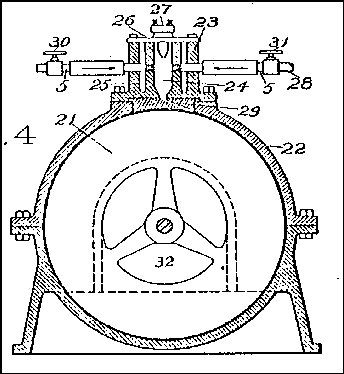
Tesla's Valvular Conduit Patent: Fig. 4 (left) exemplifies a particularly valuable application of the invention to which reference has been made above. The drawing shows in vertical cross section a turbine which may be of any type but is in this instance one invented and described by me and supposed to be familiar to engineers.
Suffice it to state that the rotor 21 of the same is composed of flat plates which are set in motion through the adhesive and viscous action of the working fluid, entering the system tangentially at the periphery and leaving it at the center.
Such a machine is a thermodynamic transformer of an activity surpassing by far that of any other prime mover, it being demonstrated in practice that each single disk of the rotor is capable of performing as much work as a whole bucket-wheel. Besides, a number of other advantages, equally important, make it especially adapted for operation as an internal combustion motor .
This may be done in many ways, but the simplest and most direct plan of which I am aware is the one illustrated here. Referring again to the drawing, the upper part of the turbine casing 22 has bolted to it a separate casting 23, the central cavity 24 of which forms the combustion chamber. To prevent injury through excessive heating a jacket 25 may be used, or else water injected, and when these means are objectionable recourse may be had to air cooling, this all the more readily as very high temperatures are practicable. The top of casting 23 is closed by a plate 26 with a sparking or hot wire plug 27 and in its sides are screwed two valvular conduits communicating with the central chamber 24. One of these is, normally, open to the atmosphere while the other connects to a source of fuel supply as a gas main 28. The bottom of the combustion chamber terminates in a suitable nozzle 29 which consists of separate piece of heat resisting material.
To regulate the influx of the explosion constituents and secure the proper mixture of air and gas conduits are equipped, respectively, with valves 30 and 31. The exhaust openings 32 of the rotor should be in communication with a ventilator, preferably carried on the same shaft and of any suitable construction. Its use, however, while advantageous, is not indispensable the suction produced by the turbine rotor itself being, in some cases, at least, sufficient to insure proper working. This detail is omitted from the drawing as unessential to the understanding. But a few words will be needed to make clear the mode of operation. The air valve 30 being open and sparking established across terminals 27, the gas is turned on slowly until the mixture in the chamber 24 reaches the critical state and is ignited. Both the conduits behaving, with respect to influx, as closed valves, the products of combustion rush out through the nozzle 29 acquiring still greater velocity by expansion and, imparting their momentum to the rotor 21, start it from rest.
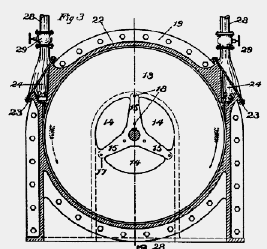
Upon the subsidence of the explosion the pressure in the chamber sinks below the atmosphere owing to the pumping action of the rotor or ventilator and new air and gas is permitted to enter, cleaning the cavity and channels and making up a fresh mixture which is detonated as before, and so on, the successive impulses of the working fluid producing an almost continuous rotary effort. After a short lapse of time the chamber becomes heated to such a degree that the ignition device may be shut off without disturbing the established regime. This manner of starting the turbine involves the employment of an unduly large combustion chamber which is not commendable from the economic point of view, for not only does it entail increased heat losses but the explosions cannot be made to follow one another with such rapidity as would be desirable to insure the best valvular action. When the chamber is small an auxiliary means for starting, as compressed air, may be resorted to and a very quick succession of explosions can then be obtained.
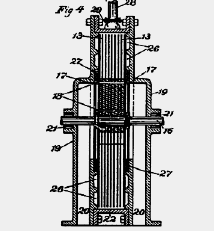
The frequency will be the greater the stronger the suction, and may, under certain conditions, reach hundreds and even thousands per second. It scarcely need be stated that instead of one, several explosion chambers may be used for cooling purposes and also to increase the number of active pulses and the output of the machine.
Apparatus as illustrated in Fig. 4 presents the advantages of extreme simplicity, cheapness and reliability, there being no compressor, buckets or troublesome valve mechanism.
It also permits, with the addition of certain well known accessories, the use of any kind of fuel and thus meets the pressing necessity of a self- contained, powerful, light and compact internal combustion motor for general work. When the attainment of the highest efficiency is the chief object, as in machines of large size, the explosive constituents will be supplied under high pressure and provision made for maintaining a vacuum at the exhaust. Such arrangements are quite familiar and lend themselves so easily to this improvement that an enlargement on this subject is deemed unnecessary...

The high efficiency of the device, irrespective of the character of the pulses, is due to two causes: first, rapid reversal of direction of flow and, second, great relative velocity of the colliding fluid columns. As will be readily seen each bucket causes a deviation through an angle of 180 degrees, and another change of 180 degrees occurs in each of the spaces between two adjacent buckets.
That is to say, from the time the fluid enters or leaves one of the recesses to its passage into, or exit from, the one following a complete cycle, or deflection through 360 degrees, is effected. Observe now that the velocity is but slightly reduced in the reversal so that the incoming and deflected fluid columns meet with a relative speed, twice that of the flow, and the energy of their impact is four times greater than with a deflection of only 90 degrees, as might be obtained with pockets such as have been employed in asymmetrical conduits for various purposes. The fact is, however, that in these such deflection is not secured. The pockets remaining filled with comparatively quiescent fluid and the latter following a winding path of least resistance between the obstacles interposed. In such conduits the action cannot be characterized as "valvular" because some of the fluid can pass almost unimpeded in a direction opposite to the normal flow. In my construction, as above indicated, the resistance in the reverse may be 200 times that in the normal direction. Owing to this a comparatively very small number of buckets or elements is required for checking the fluid. Complete Patent information - Tesla's Valvular Conduit Patent -
A NEW ADVANCE IN TESLA TURBINE THEORY
Observant students of the Tesla Turbine design might have wondered why some of Tesla's engines do not appear to use a labyrinth seal between the end disks and the corresponding engine casing end plates. After all, the patent drawings clearly show these seals and the accompanying text describes them at length. At the same time, photographs of the dual 200 H.P. turbine installed at the Edison Waterside plant in New York reveal an absence of this feature.
It is believed the answer lies in the design of the engine's inlet nozzle. (click on image - left - for larger view) It has been proposed that the slot shaped nozzle might have been constructed in such a manner that the propelling gas was never allowed to enter directly into the two interdiscular spaces nearest to the ends of the rotor.
In other words, it is believed the nozzle slot was narrower than the overall width of the rotor, by slightly more than two spaces. It might be said that the total number of disks was greater by two than the number of active disks. For example, a turbine with 25 disks, including the thicker end disks, might be described as having 23 active disks. This would allow any of the propelling gas which did get past the outermost active disks to pass through the two outermost interdiscular spaces rather than between the end disks and the engine's end plates, specifically...Compliments: Gary Peterson (Twenty First Century Books).
Tesla's two variations of inlet nozzles
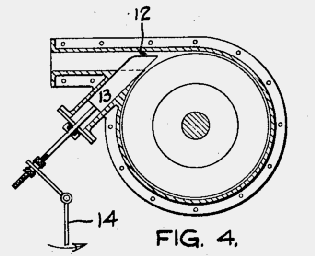
In FIG #4, Tesla used a variable inlet nozzle #12, and controlled the amount of gas entering by a movable "block" - #13.
Note that also, in FIG #4, the inlet and exhaust port size was increased, to allow for more power, on demand.
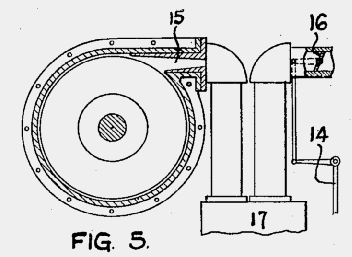
Tesla, in FIG #5 used a diverging inlet nozzle - #15, controlled by a "butterfly" valve, #16 .
This design was to be incorporated into Tesla's ''flying machine'', with two 10'' turbines, rated at 400 HP
REF: Tesla Patent # 1,655,114 of 1928.
A word about inlet nozzles and the Anharmonic Resonator:
Looking at the diagram of the anharmonic resonator (which would include the types of nozzles Tesla was using); Sonic gas speed will occur at the smallest area cross section between a high pressure reservoir and the turbine discs. Supersonic gas flow speeds will only occur immediately downstream of a region of sonic speed (smallest cross section) and only if the cross section gradually increases. This has been proven in laboratories hundreds of times. If all gas flow properties are being regulated at the inlet nozzle immediately upstream of the turbine discs, that will be the region where sonic gas speed will occur. All cross sections upstream of the nozzle and up to the exit of the high-pressure reservoir would have a greater cross-section area. The best location to regulate gas pressure and the mass flow rate of the gas would be at the inlet nozzle, not the reservoir outlet.
 The anharmonic resonator (click image thumbnail, left to enlarge) will be used downstream of a regulator valve that would also be the exit of the high pressure gas reservoir. Sonic gas speed will occur in that regulator valve (it will regulate the mass flow rate of the gas and also its pressure) and the gas flow downstream of the regulator valve would go supersonic if cross section area gradually increases. Under these conditions, a device like the aharmonic resonator could break up the supersonic shock waves ahead of a Tesla turbine intake. To slow supersonic gas, the cross section area needs to be reduced. The anharmonic resonator is essentially a modification of the Oswatitsch intake that is used at the entrance to the engines of supersonic aircraft. The Macrosonix-type intake would break up the sound waves so as to reduce the pressure loss as the air slows from supersonic speed to subsonic speed.
The anharmonic resonator (click image thumbnail, left to enlarge) will be used downstream of a regulator valve that would also be the exit of the high pressure gas reservoir. Sonic gas speed will occur in that regulator valve (it will regulate the mass flow rate of the gas and also its pressure) and the gas flow downstream of the regulator valve would go supersonic if cross section area gradually increases. Under these conditions, a device like the aharmonic resonator could break up the supersonic shock waves ahead of a Tesla turbine intake. To slow supersonic gas, the cross section area needs to be reduced. The anharmonic resonator is essentially a modification of the Oswatitsch intake that is used at the entrance to the engines of supersonic aircraft. The Macrosonix-type intake would break up the sound waves so as to reduce the pressure loss as the air slows from supersonic speed to subsonic speed.
This device will only have use if the gas flowing toward the intake nozzle of a Tesla turbine is already traveling at supersonic speed. If the gas speed is subsonic and with no hope of it ever going supersonic, then the device would either do nothing or it will cause problems if it is not designed properly. If you want to run a Tesla turbine when the air at the intake to the nozzle is supersonic, an Oswatitsch intake may involve lower energy losses that this resonator. Both devices would work best in an aircraft traveling at supersonic speed and a Tesla turbine was being used on board to drive electrical generation equipment or hydraulic equipment.
Mass flow rate of gas into a Tesla turbine can be regulated by using a rectangular cross-section of inlet nozzle. It is very easy to achieve adjustable and variable cross-section area from a rectangular nozzle. An alternative would be to use multiple nozzles of varying cross-section areas. Operate some nozzles and keep others shut off so as to achieve the desired mass flow rate of gas into the Tesla Discs. 4-nozzles in a 1:2:4:8 cross section ratio will give a 1:2:4:8 mass flow rate ratio into the Tesla discs, which in turn would yield 15-mass flow settings and also 15-power settings in equal steps.
From the "New York Herald Tribune", Oct. 15th 1911
Tesla's New Monarch of Machines
Suppose some one should discover a new mechanical principle--something as fundamental as James Watt's discovery of the expansive power of steam--by the use of which it became possible to build a motor that would give ten horse power for every pound of the engine's weight, a motor so simple that the verist novice in mechanics could construct it and so elemental that it could not possibly get out of repair. Then suppose that this motor could be run forward or backward at will, that it could be used as either an engine or a pump, that it cost almost nothing to build as compared with any other known form of engine, that it utilized a larger percentage of the available power than any existing machine, and, finally, that it would operate with gas, steam, compressed air or water, any one of them, as its driving power.
It does not take a mechanical expert to imagine the limitless possibilities of such an engine. It takes very little effort to conjure up a picture of a new world of industry and transportation made possible by the invention of such a device. "Revolutionary" seems a mild term to apply to it. That, however, is the word the inventor uses in describing it--Nikola Tesla, the scientist whose electrical discoveries underlie all modern electrical power development, whose experiments and deductions made the wireless telegraph possible, and who now, in the mechanical field, has achieved a triumph even more far reaching than anything he accomplished in electricity.
There is something of the romantic in this discovery of the famous explorer of the hidden realms of knowledge. The pursuit of an ideal is always romantic, and it was in the pursuit of an ideal which he has been seeking twenty years that Dr. Tesla made his great discovery. That ideal is the power to fly--to fly with certainty and absolute safety--not merely to go up in an airplane and take chances on weather conditions, "holes in the air," tornadoes, lightning and the thousand other perils the aviator of today faces, but to fly with the speed and certainty of a cannon ball, with power to overcome any of nature's aerial forces, to start when one pleases, go whither one pleases and alight where one pleases. That has been the aim of Dr. Tesla's life for nearly a quarter of a century. He believes that with the discovery of the principle of his new motor he has solved this problem and that incidentally he has laid the foundations for the most startling new achievements in other mechanical lines.
There was a time when men of science were skeptical--a time when they ridiculed the announcement of revolutionary discoveries. Those were the days when Nikola Tesla, the young scientist from the Balkans, was laughed at when he urged his theories on the engineering world. Times have changed since then, and the "practical" engineer is not so incredulous about "scientific" discoveries. The change came about when young Tesla showed the way by which the power of Niagara Falls could be utilized. The right to divert a portion of the waters of Niagara had been granted; then arose the question of how best to utilize the tremendous power thus made available--how to transmit it to the points where it could be commercially utilized. An international commission sat in London and listened to theories and practical plans for months.
Up to that time the only means of utilizing electric power was the direct current motor, and direct current dynamos big enough to be of practical utility for such a gigantic power development were not feasible. Then came the announcement of young Tesla's discovery of the principle of the alternating current motor. Practical tests showed that it could be built--that it would work. That discovery, at that opportune time, decided the commission. Electricity was determined upon as the means for the transmission of Niagara's power to industry and commerce.
Today a million horse power is developed on the brink of the great cataract, turning the wheels of Buffalo, Rochester, Syracuse and the intervening cities and villages operating close at hand the great new electrochemical industries that the existence of this immense source of power has made possible, while all around the world a thousand waterfalls are working in the service of mankind, sending the power of their "white coal" into remote and almost inaccessible corners of the globe, all because of Nikola Tesla's first great epoch making discovery.
Today the engineering world listens respectfully when Dr. Tesla speaks. The first announcement of the discovery of his new mechanical principle was made in a technical periodical in mid-September, 1911. Immediately it became the principal topic of discussions wherever engineers met. "It is the greatest invention in a century," wrote one of the foremost American engineers, a man whose name stands close to the top of the list of those who have achieved scientific fame and greatness. "No invention of such importance in the automobile trade has yet been made," declared the editor of one of the leading engineering publications.
Experts in other engineering lines pointed out other applications of the new principle and letters asking for further information poured in on Dr. Tesla from the four quarters of the globe. "Oh, I've had too much publicity," he said, when I telephoned to him to ask for an interview in order to explain his new discovery to the non-technical public. It took a good deal of persuasion before he reluctantly fixed an hour when he would see me, and a good bit more after that before he talked at all freely. When he did speak, however, he opened up vistas of possible applications of the new engine that staggered the imagination of the interviewer.
Looking out over the city from the windows of his office, on the twentieth floor of the Metropolitan Tower, his face lit up as he told of his life dream and its approaching realization, and the listener's fancy could almost see the air full of strange flying craft, while huge steamships propelled at unheard of speeds plough the waters of the North River, automobiles climbed the very face of the Palisades, locomotives of incredible power whisked wheeled palaces many miles a minute and all the discomforts of summer heat vanished as marvelous refrigerating plants reduced the temperature of the whole city to a comfortable maximum--for these were only a few of the suggestions of the limitless possibilities of the latest Tesla discovery.
"Just what is your new invention?" I asked. "I have accomplished what mechanical engineers have been dreaming about ever since the invention of steam power," replied Dr. Tesla. " That is the perfect rotary engine. It happens that I have also produced an engine which will give at least twenty-five times as much power to a pound of weight as the lightest weight engine of any kind that has yet been produced. "In doing this I have made use of two properties which have always been known to be possessed by all fluids, but which have not heretofore been utilized. These properties are adhesion and viscosity."
"Put a drop of water on a metal plate. The drop will roll off, but a certain amount of the water will remain on the plate until it evaporates or is removed by some absorptive means. The metal does not absorb any of the water, but the water adheres to it. The drop of water may change its shape, but until its particles are separated by some external power it remains intact. This tendency of all fluids to resist molecular separation is viscosity. It is especially noticeable in the heavier oils. It is these properties of adhesion and viscosity that cause the 'skin friction' that impedes a ship in its progress through the water or an airplane in going through the air. All fluids have these qualities--and you must keep in mind that air is a fluid, all gases are fluids, steam is fluid. Every known means of transmitting or developing mechanical power is through a fluid medium."
"Now, suppose we make this metal plate that I have spoken of circular in shape and mount it at its center on a shaft so that it can be revolved. Apply power to rotate the shaft and what happens? Why, whatever fluid the disk happens to be revolving in is agitated and dragged along in the direction of rotation, because the fluid tends to adhere to the disk and the viscosity causes the motion given to the adhering particles of the fluid to be transmitted to the whole mass. Here, I can show you better than tell you."
Dr. Tesla led the way into an adjoining room. On a desk was a small electric motor and mounted on the shaft were half a dozen flat disks, separated by perhaps a sixteenth of an inch from one another, each disk being less than that in thickness. He turned a switch and the motor began to buzz. A wave of cool air was immediately felt. "There we have a disk, or rather a series of disks, revolving in a fluid--the air," said the inventor. "You need no proof to tell you that the air is being agitated and propelled violently. If you will hold your hand over the center of these disks--you see the centers have been cut away--you will feel the suction as air is drawn in to be expelled from the peripheries of the disks. Now, suppose these revolving disks were enclosed in an air tight case, so constructed that the air could enter only at one point and be expelled only at another--what would we have?" "You'd have an air pump," I suggested. "Exactly--an air pump or blower," said Dr. Tesla. "There is one now in operation delivering ten thousand cubic feet of air a minute. Now, come over here."...
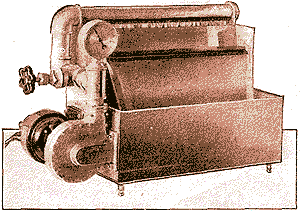
...He stepped across the hall and into another room, where three or four draughts men were at work and various mechanical and electrical contrivances were scattered about. At one side of the room was what appeared to be a zinc or aluminum tank, divided into two sections, one above the other, while a pipe that ran along the wall above the upper division of the tank was connected with a little aluminum case about the size and shape of a small alarm clock. A tiny electric motor was attached to a shaft that protruded from one side of the aluminum case. The lower division of the tank was filled with water. "Inside of this aluminum case are several disks mounted on a shaft and immersed in a fluid, water," said Dr. Tesla. "From this lower tank the water has free access to the case enclosing the disks. This pipe leads from the periphery of the case. I turn the current on, the motor turns the disks and as I open this valve in the pipe the water flows."...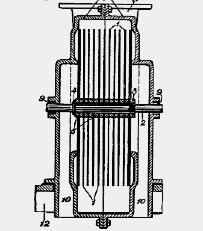
He turned the valve and the water certainly did flow. Instantly a stream that would have filled a barrel in a very few minutes began to run out of the pipe into the upper part of the tank and thence into the lower tank. "This is only a toy," said Dr. Tesla. "There are only half a dozen disks--'runners,' I call them--each less than three inches in diameter, inside of that case. They are just like the disks you saw on the first motor--no vanes, blades or attachments of any kind. Just perfectly smooth, flat disks revolving in their own planes and pumping water because of the viscosity and adhesion of the fluid. One such pump now in operation, with eight disks, eighteen inches in diameter, pumps four thousand gallons a minute to a height of 360 feet." We went back into the big, well lighted office. I was beginning to grasp the new Tesla principle. "Suppose now we reversed the operation," continued the inventor. "You have seen the disks acting as a pump. Suppose we had water, or air under pressure, or steam under pressure, or gas under pressure, and let it run into the case in which the disks are contained--what would happen?"...
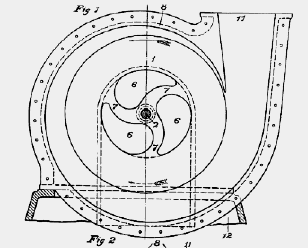
"The disks would revolve and any machinery attached to the shaft would be operated--you would convert the pump into an engine," I suggested. "That is exactly what would happen--what does happen," replied Dr. Tesla. "It is an engine that does all that engineers have ever dreamed of an engine doing, and more. Down at the Waterside power station of the New York Edison Company, through their courtesy, I have had a number of such engines in operation. In one of them the disks are only nine inches in diameter and the whole working part is two inches thick. With steam as the propulsive fluid it develops 110-horse power, and could do twice as much." "You have got what Professor Langley was trying to evolve for his flying machine--an engine that will give a horse power for a pound of weight," I suggested...
Ten Horse Power to the Pound !
"I have got more than that," replied Dr. Tesla. "I have an engine that will give ten horse power to the pound of weight. That is twenty-five times as powerful as the lightest weight engine in use today. The lightest gas engine used on airplanes weighs two and one-half pounds to the horse power. With two and one-half pounds of weight I can develop twenty-five horse power."
"That means the solution of the problem of flying," I suggested. "Yes, and many more," was the reply. "The applications of this principle, both for imparting power to fluids, as in pumps, and for deriving power from fluids, as in turbine, are boundless. It costs almost nothing to make, there is nothing about it to get out of order, it is reversible--simply have two ports for the gas or steam, to enter by, one on each side, and let it into one side or other. There are no blades or vanes to get out of order--the steam turbine is a delicate thing." I remembered the bushels of broken blades that were gathered out of the turbine casings of the first turbine equipped steamship to cross the ocean, and realized the importance of this phase of the new engine.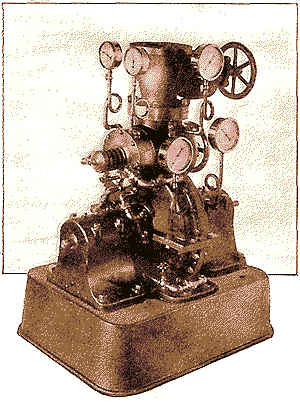
"Then, too," Dr. Tesla went on, "there are no delicate adjustments to be made. The distance between the disks is not a matter of microscopic accuracy and there is no necessity for minute clearances between the disks and the case. All one needs is some disks mounted on a shaft, spaced a little distance apart and cased so that a fluid can enter at one point and go out at another. If the fluid enters at the center and goes out at the periphery it is a pump."
"If it enters at the periphery and goes out at the center it is a motor. "Coupling these engines in series, one can do away with gearing in machinery. Factories can be equipped without shafting. The motor is especially adapted to automobiles, for it will run on gas explosions as well as on steam. The gas or steam can be let into a dozen ports all around the rim of the case if desired. It is possible to run it as a gas engine with a continuous flow of gas, gasoline and air being mixed and the continuous combustion causing expansion and pressure to operate the motor."
"The expansive power of steam, as well as its propulsive power, can be utilized as in a turbine or a reciprocating engine. By permitting the propelling fluid to move along the lines of least resistance a considerably larger proportion of the available power is utilized. "As an air compressor it is highly efficient. There is a large engine of this type now in practical operation as an air compressor and giving remarkable service. Refrigeration on a scale hitherto never attempted will be practical, through the use of this engine in compressing air, and the manufacture of liquid air commercially is now entirely feasible. With a thousand horse power engine, weighing only one hundred pounds, imagine the possibilities in automobiles, locomotives and steamships. In the space now occupied by the engines of the Lusitanian twenty-five times her 80,000 horse power could be developed, were it possible to provide boiler capacity sufficient to furnish the necessary steam." "And it makes the airplane practical," I suggested.
"Not the airplane, the flying machine," responded Dr. Tesla. " Now you have struck the point in which I am most deeply interested--the object toward which I have been devoting my energies for more than twenty years--the dream of my life. It was in seeking the means of making the perfect flying machine that I developed this engine."
 "Twenty years ago I believed that I would be the first man to fly; that I was on the track of accomplishing what no one else was anywhere near reaching. I was working entirely in electricity then and did not realize that the gasoline engine was approaching a perfection that was going to make the airplane feasible. There is nothing new about the airplane but its engine, you know. What I was working on twenty years ago was the wireless transmission of electric power.
My idea was a flying machine propelled by an electric motor, with power supplied from stations on the earth. I have not accomplished this as yet, but am confident that I will in time. When I found that I had been anticipated as to the flying machine, by men working in a different field I began to study the problem from other angles, to regard it as a mechanical rather than an electrical problem. I felt certain there must be some means of obtaining power that was better than any now in use, and by vigorous use of my gray matter for a number of years I grasped the possibilities of the principle of the viscosity and adhesion of fluids and conceived the mechanism of my engine."
"Twenty years ago I believed that I would be the first man to fly; that I was on the track of accomplishing what no one else was anywhere near reaching. I was working entirely in electricity then and did not realize that the gasoline engine was approaching a perfection that was going to make the airplane feasible. There is nothing new about the airplane but its engine, you know. What I was working on twenty years ago was the wireless transmission of electric power.
My idea was a flying machine propelled by an electric motor, with power supplied from stations on the earth. I have not accomplished this as yet, but am confident that I will in time. When I found that I had been anticipated as to the flying machine, by men working in a different field I began to study the problem from other angles, to regard it as a mechanical rather than an electrical problem. I felt certain there must be some means of obtaining power that was better than any now in use, and by vigorous use of my gray matter for a number of years I grasped the possibilities of the principle of the viscosity and adhesion of fluids and conceived the mechanism of my engine."
"Now that I have it, my next step will be the perfect flying machine." "An airplane driven by your engine?" I asked. "Not at all," said Dr. Tesla. "The airplane is fatally defective. It is merely a toy--a sporting plaything. It can never become commercially practical. It has fatal defects. One is the fact that when it encounters a downward current of air it is helpless. The 'hole in the air' of which aviators speak is simply a downward current, and unless the airplane is high enough above the earth to move laterally but can do nothing but fall. "There is no way of detecting these downward currents, no way of avoiding them, and therefore the airplane must always be subject to chance and its operator to the risk of fatal accident. Sportsmen will always take these chances, but as a business proposition the risk is too great."
"
The flying machine of the future -- my flying machine -- will be heavier than air, but it will not be an airplane. It will have no  wings. It will be substantial, solid, stable. You cannot have a stable airplane. The gyroscope can never be successfully applied to the airplane, for it would give a stability that would result in the machine being torn to pieces by the wind, just as the unprotected airplane on the ground is torn to pieces by a high wind. My flying machine will have neither wings nor propellers. You might see it on the ground and you would never guess that it was a flying machine. Yet it will be able to move at will through the air in any direction with perfect safety, higher speeds than have yet been reached, regardless of weather and oblivious of 'holes in the air' or downward currents. It will ascend in such currents if desired. It can remain absolutely stationary in the air even in a wind for great length of time. Its lifting power will not depend upon any such delicate devices as the bird has to employ, but upon positive mechanical action."
wings. It will be substantial, solid, stable. You cannot have a stable airplane. The gyroscope can never be successfully applied to the airplane, for it would give a stability that would result in the machine being torn to pieces by the wind, just as the unprotected airplane on the ground is torn to pieces by a high wind. My flying machine will have neither wings nor propellers. You might see it on the ground and you would never guess that it was a flying machine. Yet it will be able to move at will through the air in any direction with perfect safety, higher speeds than have yet been reached, regardless of weather and oblivious of 'holes in the air' or downward currents. It will ascend in such currents if desired. It can remain absolutely stationary in the air even in a wind for great length of time. Its lifting power will not depend upon any such delicate devices as the bird has to employ, but upon positive mechanical action."
"You will get stability through gyroscopes?" I asked. "Through gyroscopic action of my engine, assisted by some devices I am not yet prepared to talk about," he replied. "Powerful air currents that may be deflected at will, if produced by engines and compressors sufficiently light and powerful, might lift a heavy body off the ground and propel it through the air," I ventured, wondering if I had grasped the inventor's secret.
Dr. Tesla smiled an inscrutable smile. " All I have to say on that point is that my airship will have neither gas bag, wings nor propellers," he said. "It is the child of my dreams, the product of years of intense and painful toil and research. I am not going to talk about it any further. But whatever my airship may be, here at least is an engine that will do things that no other engine ever has done, and that is something tangible."
The Tesla Pump
Looking out over the city from the windows of his office, on the twentieth floor of the Metropolitan Tower, his face lit up as he told of his life dream and its approaching realization, and the listener's fancy could almost see the air full of strange flying craft, while huge steamships propelled at unheard of speeds plough the waters of the North River, automobiles climbed the very face of the Palisades, locomotives of incredible power whisked wheeled palaces many miles a minute and all the discomforts of summer heat vanished as marvelous refrigerating plants reduced the temperature of the whole city to a comfortable maximum, for these were only a few of the suggestions of the limitless possibilities of the latest Tesla discovery.
"Just what is your new invention?" I asked. "I have accomplished what mechanical engineers have been dreaming about ever since the invention of steam power," replied Dr. Tesla. "That is the perfect rotary engine. It happens that I have also produced an engine which will give at least twenty-five times as much power to a pound of weight as the lightest weight engine of any kind that has yet been produced. "In doing this I have made use of two properties which have always been known to be possessed by all fluids, but which have not heretofore been utilized. These properties are adhesion and viscosity.
"Put a drop of water on a metal plate. The drop will roll off, but a certain amount of the water will remain on the plate until it evaporates or is removed by some absorptive means. The metal does not absorb any of the water, but the water adheres to it. "The drop of water may change its shape, but until its particles are separated by some external power it remains intact. This tendency of all fluids to resist molecular separation is viscosity. It is especially noticeable in the heavier oils. "It is these properties of adhesion and viscosity that cause the 'skin friction' that impedes a ship in its progress through the water or an airplane in going through the air. All fluids have these qualities--and you must keep in mind that air is a fluid, all gases are fluids, steam is fluid. Every known means of transmitting or developing mechanical power is through a fluid medium.
 "Now, suppose we make this metal plate that I have spoken of circular in shape and mount it at its center on a shaft so that it can be revolved. Apply power to rotate the shaft and what happens? Why, whatever fluid the disk happens to be revolving in is agitated and dragged along in the direction of rotation, because the fluid tends to adhere to the disk and the viscosity causes the motion given to the adhering particles of the fluid to be transmitted to the whole mass. Here, I can show you better than tell you." Dr. Tesla led the way into an adjoining room.
"Now, suppose we make this metal plate that I have spoken of circular in shape and mount it at its center on a shaft so that it can be revolved. Apply power to rotate the shaft and what happens? Why, whatever fluid the disk happens to be revolving in is agitated and dragged along in the direction of rotation, because the fluid tends to adhere to the disk and the viscosity causes the motion given to the adhering particles of the fluid to be transmitted to the whole mass. Here, I can show you better than tell you." Dr. Tesla led the way into an adjoining room.
On a desk was a small electric motor and mounted on the shaft were half a dozen flat disks, separated by perhaps a sixteenth of an inch from one another, each disk being less than that in thickness. He turned a switch and the motor began to buzz. A wave of cool air was immediately felt. "There we have a disk, or rather a series of disks, revolving in a fluid--the air," said the inventor. "You need no proof to tell you that the air is being agitated and propelled violently. If you will hold your hand over the center of these disks--you see the centers have been cut away--you will feel the suction as air is drawn in to be expelled from the peripheries of the disks. "Now, suppose these revolving disks were enclosed in an air tight case, so constructed that the air could enter only at one point and be expelled only at another--what would we have?" "You'd have an air pump," I suggested. "Exactly--an air pump or blower," said Dr. Tesla. "There is one now in operation delivering ten thousand cubic feet of air a minute. "Now, come over here."
He stepped across the hall and into another room, where three or four draughts men were at work and various mechanical and electrical contrivances were scattered about. At one side of the room was what appeared to be a zinc or aluminum tank, divided into two sections, one above the other, while a pipe that ran along the wall above the upper division of the tank was connected with a little aluminum case about the size and shape of a small alarm clock. A tiny electric motor was attached to a shaft that protruded from one side of the aluminum case. The lower division of the tank was filled with water. "Inside of this aluminum case are several disks mounted on a shaft and immersed in a fluid, water," said Dr. Tesla. "From this lower tank the water has free access to the case enclosing the disks. This pipe leads from the periphery of the case. I turn the current on, the motor turns the disks and as I open this valve in the pipe the water flows."
He turned the valve and the water certainly did flow. Instantly a stream that would have filled a barrel in a very few minutes began to run out of the pipe into the upper part of the tank and thence into the lower tank. "This is only a toy," said Dr. Tesla. " There are only half a dozen disks--'runners,' I call them--each less than three inches in diameter, inside of that case. They are just like the disks you saw on the first motor--no vanes, blades or attachments of any kind. Just perfectly smooth, flat disks revolving in their own planes and pumping water because of the viscosity and adhesion of the fluid. One such pump now in operation, with eight disks, eighteen inches in diameter, pumps four thousand gallons a minute to a height of 360 feet." We went back into the big, well lighted office. I was beginning to grasp the new Tesla principle...
to "PART II" of the Tesla Turbine And Pump
Nikola Tesla's PATENTS
The Tesla Turbine "Yahoo Groups" List:
this list has grown substantially since its initial creation in 1999. The list is used to keep members informed of important updates, new ideas on turbine construction, and for a general forum and outlet on new and innovative concepts in the construction of the Tesla Turbine. The list is moderated by founder and creator of International Turbine And Power, LLC - Mr. Frank Germano. There are at any time approximately 6000 interested individuals on this list. If you would like to join this exciting Tesla Turbine List, use the link(s) below and follow the instructions.
Books I highly recommend
Frank D Germano, (frankdgermano at gmail dot com)
Founder and President,
International Turbine And Power
931 Rumsey Avenue, PO Box 550
Cody, Wyoming 82414
![]()
